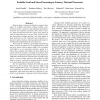Free Online Productivity Tools
i2Speak
i2Symbol
i2OCR
iTex2Img
iWeb2Print
iWeb2Shot
i2Type
iPdf2Split
iPdf2Merge
i2Bopomofo
i2Arabic
i2Style
i2Image
i2PDF
iLatex2Rtf
Sci2ools
ISCA
2005
IEEE
2005
IEEE
Scalable Load and Store Processing in Latency Tolerant Processors
Memory latency tolerant architectures support thousands of in-flight instructions without scaling cyclecritical processor resources, and thousands of useful instructions can complete in parallel with a miss to memory. These architectures however require large queues to track all loads and stores executed while a miss is pending. Hierarchical designs alleviate cycle time impact of these structures but the CAM and search functions required to enforce memory ordering and provide data forwarding place high demand on area and power. We present new load-store processing algorithms for latency tolerant architectures. We augment primary load and store queues with secondary buffers. The secondary load buffer is a set associative structure, similar to a cache. The secondary store buffer, the Store Redo Log, is a first-in first-out structure recording the program order of all stores completed in parallel with a miss, and has no CAM and search functions. Instead of the secondary store queue, a ca...
| Added | 25 Jun 2010 |
| Updated | 25 Jun 2010 |
| Type | Conference |
| Year | 2005 |
| Where | ISCA |
| Authors | Amit Gandhi, Haitham Akkary, Ravi Rajwar, Srikanth T. Srinivasan, Konrad K. Lai |
Comments (0)

